
Currently, there are over 1.3 million lawyers in the United States. But, how many female lawyers in the US? According to the ABA National Lawyer Population Survey, the percentage of female lawyers in the United States was 38.3% (more than 504,000 individuals) in 2022. Although their number has grown over the years, there are still fewer women in law than men.

This article will delve into the statistics and trends surrounding female lawyers in the US. And at the end, you’ll find a bonus where we look at the women lawyers’ well-being and organizations advocating for them. Let’s start!
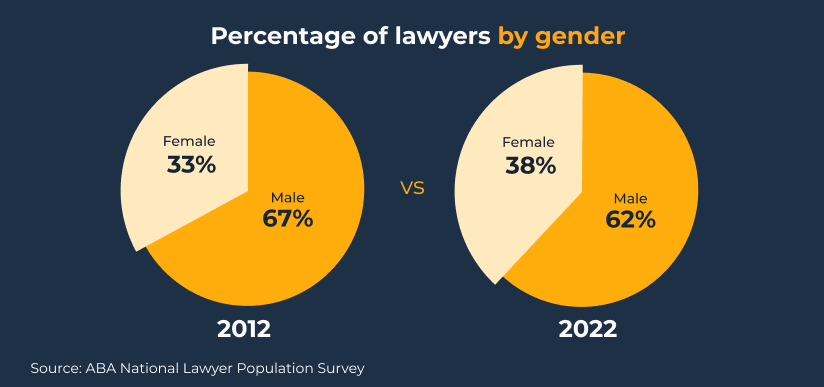
Years ago, almost no women were lawyers. Margaret Brent became the U.S.’s first female lawyer in Maryland in 1648. By 2021, about 37% of lawyers were women.
Here are some quick facts on historical context:
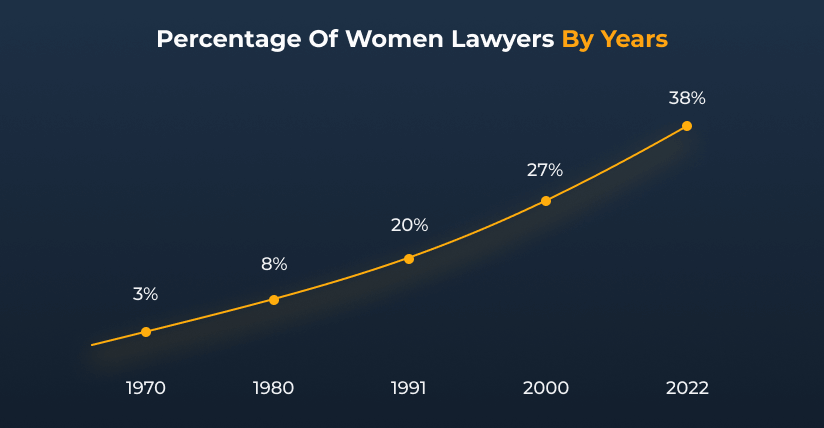
By 2022, that number went up a bit to almost 40%. So, while there are still more male lawyers, the gap is closing. This is because more women are going to law school these days compared to men.
Women are entering the legal field as law school graduates at rates equal to or exceeding men. But, they leave the profession sooner and more often than men. At the same time, there were more than 504 thousand female lawyers in the United States in 2022.
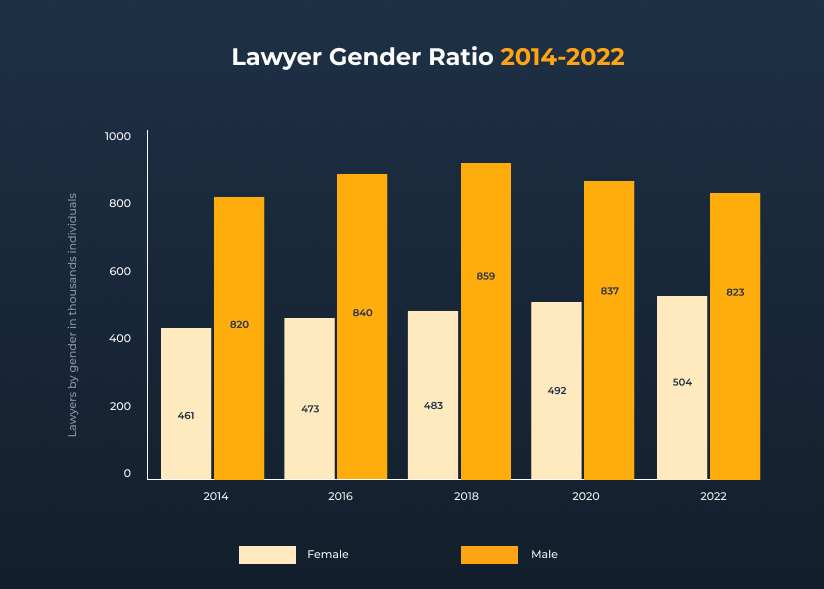
Now, let’s shift our focus to what percentage of lawyers are women in law firms.
Even though women make up almost 50% of law firm associates, their numbers among equity partners are much lower, at only 22% in 2021. This shows there’s a big difference in leadership roles. In 2020, women were more prevalent at junior levels in law firms, making up 47% of associates and 32% of non-equity partners.
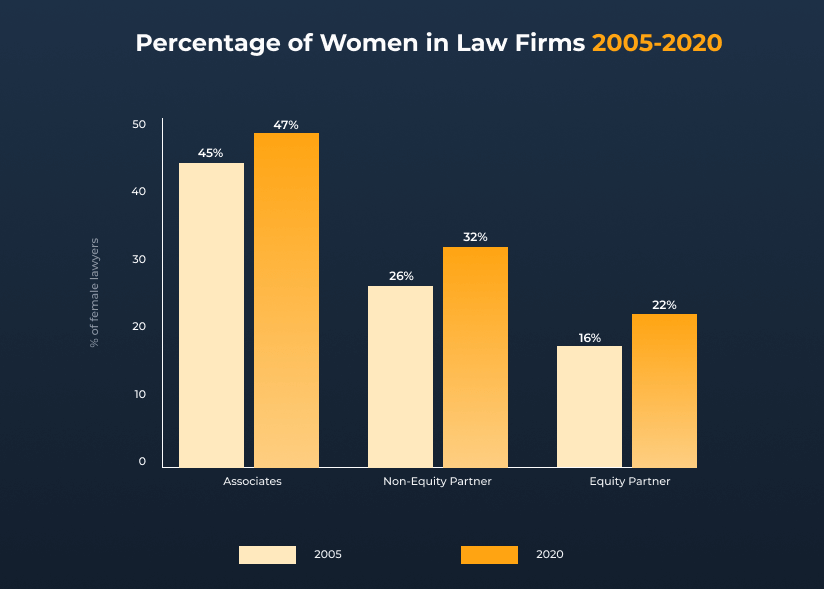
Gender bias can influence how law firms check performance and make promotion decisions.
According to a report by the National Association of Women Lawyers (NAWL), women account for:
Often, law firms don’t establish clear promotion criteria, which leads to subjective decision-making. Departing partners handle succession planning and may favor individuals who resemble them.

Men earn more than women at every level in a law firm, from associates to equity partnerships. In 2020, female associates and non-equity partners earned, on average, 95% of what their male colleagues earned. But, the pay gap widened at the top; female equity partners earned only 78% of what male equity partners made.
Associate
95%
Non-Equity Partner
90%
Equity Partner
78%
The most highly compensated attorney in law firms is usually a man.
Although the percentage of female partners in law firms is 12%, they are rarely among the highest paid in the company.

Read also our article “Suing for Emotional Distress: Rights and Remedies“
In 1928, the government appointed the first female federal judge, who joined a bench of 217 men. By 1950, only three women held such roles. In 1980, the number rose to 46. As of July 2022, 424 female lawyers in court serve as federal judges, making up 30% of the total.
In State Supreme Courts, women fare better, comprising 41% of justices, as per a 2022 Brennan Center survey.
The states with the highest concentration of female judges (over 80%) are Washington, Wisconsin, New Mexico, and Hawaii. The lowest concentration is in Mississippi (11% of the total number of judges), Florida, and Louisiana (14%).
Let’s find out the percentage of lawyers by race and gender in states with the highest and lowest concentrations of female lawyers.
Washington
8
88%
38%
Wisconsin
7
86%
0%
New Mexico
5
80%
40%
Hawaii
5
80%
40%
Florida
7
14%
0%
Louisiana
7
14%
14%
Mississippi
9
11%
0%
There are positive developments in gender diversity. 15 out of the 25 new justices who have taken office on the state supreme court since April 2021 are women.
For years, law schools were mostly filled with white men. Progress unfolded over decades. In 1963, females made up only 4% of first-year law students. This figure rose to 20% in 1973, 39% in 1983, and reached 44% by 1993. In 2014, more first-year students were female than male. By 2016, women became the majority at ABA-accredited law schools, comprising 50.3% of all JD students.
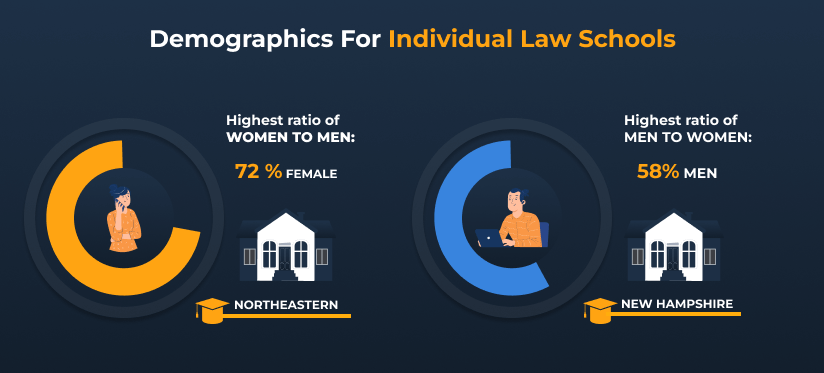
The future looks promising, especially with the increasing percentage of women in law school. Now, 8 of the top 10 law schools ranked by U.S. News in 2023 have more female students than male. This shift could balance the lawyer gender ratio.
1
Stanford University
52%
2
Yale University
51.8%
3
University of Chicago
48%
4
University of Pennsylvania (Carey)
53.74%
5
Duke University
56.1%
6
Harvard University
54%
7
New York University
61.6%
8
Columbia University
48.9%
9
University of Virginia
51%
10
Northwestern University (Pritzker)
62%
In 2021, women made up 55.3% of students at ABA-accredited law schools. There were 12,803 more female JD students than male ones, with an extra 378 identifying as neither.

Check out our article “Know Your Terms: Prison vs Jail – What’s the Difference?“
Stats can tell us a lot, but they don’t capture the nuanced challenges and support systems that exist within the legal profession for women. That’s why we’re going deeper with these extra insights. We’ll look at the well-being of women lawyers and the organizations advocating for changes.
The well-being of female lawyers has been a growing concern, especially when compared to their male counterparts. An ABA survey revealed some alarming statistics about the mental health and stress levels among female lawyers vs male lawyers:
The survey also found that more women than men (24% vs. 17%) considered leaving the legal profession due to mental health problems, burnout, or stress.
Women who experienced more conflicts between work and family were four times more likely to consider leaving the legal profession. This conflict was also a significant factor for men but to a lesser extent.
Several national organizations actively commit to the well-being of women lawyers, offering a plethora of resources, mentorship programs, educational initiatives, and advocacy efforts. Below are key organizations making significant strides in this area.
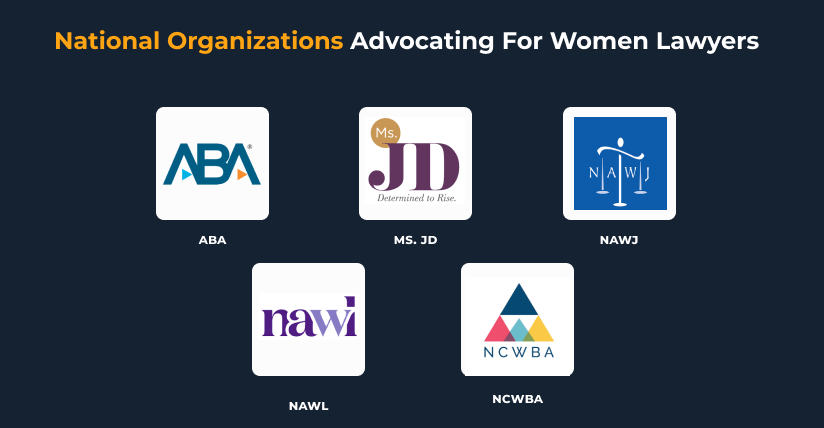
Women in the Profession is an integral part of the American Bar Association (ABA), a leading legal association in the United States.
NAWJ is an inclusive and diverse organization, welcoming both men and women from various courts, including trial, appellate, administrative, tribal, military, federal, state, and international tribunals.
The Women Lawyers’ Club established NAWL in New York City in 1899.
NCWBA is a unique association dedicated solely to women’s bar associations.
Each of these organizations stays to shape the future of women in law. They offer invaluable support and resources to help female lawyers navigate the challenges they face, thereby contributing to a more fair legal landscape.
Things are getting better for female lawyers in the U.S. More women are becoming lawyers and going to law school. But, they still don’t get paid as much as men and aren’t often in big boss roles. But, the increasing number of females enrolling in top law schools suggests a brighter future for female law.
According to the ABA’s National Lawyer Population Survey, there were 1,327,010 active lawyers in the United States.
In 2022, 38.3% of lawyers in the United States were female.
There are more than 818,766 male lawyers in the US as of 2022.
Black or African American individuals make up 5.4% of all lawyers, and Black women account for 3.17% of all associates.










